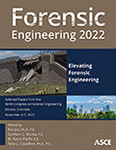Which Shear Test for Bonded Concrete?
Publication: Forensic Engineering 2022
ABSTRACT
While hundreds of standards exist for testing the physical properties of many materials, there is no industry standard for testing shear strength in concrete. Ascertaining the actual shear strength across a bonded concrete interface, such as at repairs or construction joints, is particularly problematic. In investigating planar strength, the shear strength between concrete surfaces is of primary importance. Studies from the late 19th century to the present day have not resulted in a universally accepted standard test to determine the bonded concrete shear strength. Although there is no ASTM standard for a direct shear test at the bonded concrete interface, several methods used in various locations throughout the United States include the Brookhaven National Laboratory Guillotine Shear Test and the Iowa Shear test. Other shear test methods available include the Asymmetric Four-Point Bending, Bond Test (also called the Tensile Bond Test or Pull-Off Test), CTL Thompson Method, Iosipescu-65 Method, Jacking Shear Test (also called Push-Off Test), Slant Shear Test, Torsional Shear Test, and US Bureau of Reclamation Shear Tests. Also, this paper summarizes historical and recent research results at the University of Colorado Denver where different devices test direct shear in bonded concrete specimens. The research objective is to determine each shear test method’s pros and cons, and recommend one method as a universal standard regardless of the bonding agent or method.
Get full access to this article
View all available purchase options and get full access to this chapter.
REFERENCES
ACI (American Concrete Institute). (2019). ACI 318-19 Building Code Requirements for Assessment, Repair, and Rehabilitation of Existing Concrete Structures and Commentary. (n.d.). Standard ACI 318-19. First Printing. ACI, Farmington, MI.
ACI (American Concrete Institute). (2016). ACI 562-16 Code Requirements for Assessment Repair and Rehabilitation of Existing Structures and Commentary. Second Printing. ACI, Farmington Hills, MI.
ASTM. (2013). ASTM C1583 Standard Test Method for Tensile Strength of Concrete Surfaces and the Bond Strength or Tensile Strength of Concrete Repair and Overlay Materials by Direct Tension, (Pull-Off Method) (ASTM C1583, 2013). West Conshohocken, PA.
BMPR-IL (Bureau of Materials and Physical Research, Illinois Laboratory Test). (2007). “Standard Method of Test for Shear Strength of Bonded Polymer Concrete,” <https://www.idot.illinois.gov/Assets/uploads/files/Doing-Business/Manuals-Guides-&-Handbooks/Highways/Materials/Concrete/Shear%20Strength%20of%20Polymer%20Concrete.pdf>10 FEB 2021.
Cable, J. K. (1995). Bond Development in Concrete Overlays, Iowa Department of Transportation, Dec 1995. 21–22.
Cardillo, C. J. (2018). Testing Shear Strength of Concrete Cylinders Using the Iosipescu Method, Masters Thesis, Civil Engineering Dept., University of Colorado Denver, Denver, CO., 15-20, 34-38.
Helmick, C. G., Toker-Beeson, S., and Tanner, J. E. “Evaluation of Shear and Diagonal Tension in Plain Concrete,” Concrete International, V. 38, No. 1, Jan. 2016, 39–46.
Iowa Department of Transportation. “Method of Test for Determining the Shear Strength of Bonded Concrete,” Test Method No. Iowa 406-C,” <https://www.odot.org/materials/pdfs-ohdl/ia406c.pdf>(May 2000).
Kriegh, J. D. (1976). “Arizona Slant Shear Test: A Method To Determine Epoxy Bond Strength,” ACI Journal, American Concrete Institute Farmington Hills, MI, 372–373.
Nogueria, C. L. (2018). “A New Method to Test Concrete Tensile and Shear Strength with Cylindrical Specimens,” ACI Materials Journal, American Concrete Institute, Farmington Hills, MI, 909–923.
Pultorak, A. S. (2016). The Effects of Common Surface Pretreatments on the Shear Strength of Bonded Concrete Overlays. Master’s Thesis, Civil Engineering Dept., Univ. of Colorado Denver, Denver, CO. 15-28, 49-59.
Riding, K. A., and Donjuan, J. (2014). Evaluation of Bonding Agent Application on Concrete Patch Performance. ; 2200 Vine St.PO Box 830851Lincoln, NE 68583-0851. 33.
Rosen, C. J. (2016). Shear Strength at the Interface of Bonded Concrete Overlays. Master’s Thesis, Civil Engineering Dept., Univ. of Colorado Denver, Denver, CO. 15-24, 30-55.
Sprinkel, M. M. (2016). “Bond Strength Between Shotcrete Overlay and Reinforced Concrete Base.”, January/February 2016, St Paul, MN.
Swan, A. E. (2016). Alternate Method for Testing Shear Strength at a Bonded Concrete Interface, Master’s Thesis, Civil Engineering Dept., Univ.of Colorado Denver, Denver, CO. 12-17.
Information & Authors
Information
Published In
History
Published online: Nov 2, 2022
Authors
Metrics & Citations
Metrics
Citations
Download citation
If you have the appropriate software installed, you can download article citation data to the citation manager of your choice. Simply select your manager software from the list below and click Download.
